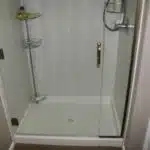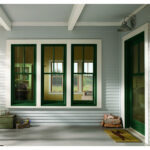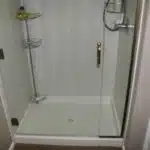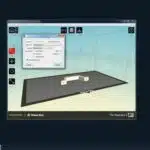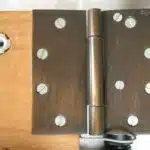Sliding screen doors are a common feature in many homes, providing ventilation while keeping insects and other pests out. However, over time these screens can become damaged or worn, requiring replacement or removal. Removing a sliding screen door may seem like a daunting task for those without experience, but with the right tools and knowledge it can be done quickly and easily.
In this article, we will provide step-by-step instructions on how to remove a sliding screen door. Whether you need to replace your existing screen or simply want to remove it temporarily for cleaning purposes, our guide will walk you through the process from start to finish. We understand that home maintenance tasks can sometimes be overwhelming, which is why we have written this article with an emphasis on clarity and simplicity. With our help, you’ll be able to remove your sliding screen door in no time, allowing you to get back to enjoying your home in comfort and style.
Necessary Tools And Materials
According to a survey conducted by the National Safety Council, over 6 million people suffer from accidents in their homes every year. Sliding screen doors can be heavy and awkward to handle, thus increasing the risk of an injury during removal. To avoid becoming a statistic, it is crucial to take necessary precautions and use the right tools when removing a sliding screen door.
Common mistakes that people make when removing a sliding screen door include not securing the door properly or underestimating its weight. This can lead to the door falling off unexpectedly or injuring someone in the process. Safety precautions such as wearing gloves and safety glasses are also essential to protect yourself from any sharp edges or debris that may result during removal.
Alternatives should be considered if you find yourself struggling with the removal process. If you have difficulty lifting the door, using a pry bar may help get it off its tracks without exerting too much force. If your screen door is old, rusty, or damaged beyond repair, it may be time to replace it altogether instead of going through the hassle of removing it.
To prepare the work area for sliding screen door removal, start by clearing out any obstacles around its track and ensuring there is enough space for you to work comfortably. Taking these initial steps will make the actual removal process more manageable and less likely to cause damage or injury.
Preparing The Work Area
Before removing a sliding screen door, it is essential to prepare the work area. This ensures that the task is completed safely and efficiently. Clearing obstacles from the door’s path will prevent any accidents or damage to other objects in the vicinity. It is also necessary to set up a workbench, which will serve as a staging area for tools and parts.
To clear obstacles in the door’s path, remove any furniture or decor that may impede movement around the door. Ensure that there is enough space to move around freely and avoid tripping over anything while working on the door. Next, check if there are any protruding screws or nails on the door frame that may cause injury during removal. Remove them if necessary using pliers or a screwdriver.
After clearing obstacles, it is time to set up a workbench near the door frame. This will provide easy access to tools and parts required for removing the sliding screen door. On the workbench, organize all necessary tools such as screwdrivers, pliers, and lubricant sprays in one place for easy accessibility. Additionally, keep all parts of the sliding screen door such as rollers and tracks within reach so that they can be easily accessed when needed.
With obstacles cleared and a workbench set up near the sliding screen door frame, you are now ready for its removal by moving onto removing track cover.
Removing The Track Cover
After preparing the work area, the next step in removing a sliding screen door is to measure the track size. This is necessary to ensure that the new screen door will fit properly. To do this, simply measure the length and width of the existing track using a measuring tape. It is important to be as accurate as possible when taking these measurements.
Once you have measured the track size, it is time to lubricate the rollers. This can be done by applying a small amount of lubricating oil to each roller. Make sure to use a lubricant that is specifically designed for use on screen doors, as other types of lubricants may cause damage or attract dirt and debris. After applying the lubricant, move the door back and forth several times to distribute it evenly.
After measuring the track size and lubricating the rollers, you are ready to proceed with loosening them. This will allow you to remove the old screen door from its track. To do this, locate the adjustment screws on each roller and use a screwdriver or wrench to turn them counterclockwise until they are loose enough to slide out of their housing. With the rollers loosened, you can now lift the screen door up and out of its track.
Loosening The Rollers
Ironically, the easiest part of removing a sliding screen door is also the most frustrating. Loosening the rollers can be accomplished with a few simple tools and a bit of patience. However, if you encounter any issues during this step, troubleshooting can be time-consuming and require some problem-solving skills.
To loosen the rollers, start by locating them at the bottom of the door on either side. You will see small screws that hold them in place. Using a screwdriver, turn each screw counterclockwise until they are loose enough to move by hand. Next, use your fingers to adjust each roller so that it is sitting properly in its track. This will ensure that the door glides smoothly when you move it.
If you run into any problems during this step, don’t panic! There are several common issues that may arise when loosening the rollers. These include rusty screws that won’t budge or rollers that have become stuck due to debris or damage. To troubleshoot these issues, consider using penetrating oil or WD-40 to loosen rusty screws, or carefully clean out any debris from around the rollers before attempting to adjust them again.
Transitioning into the subsequent section about detaching the door from the frame: Once you have successfully loosened and adjusted both rollers on your sliding screen door, it’s time to move on to detaching it from the frame.
Detaching The Door From The Frame
To detach the sliding screen door from its frame, first, lubricate the rollers. This will make it easier to remove the door without damaging either the frame or door. Lubricating will also ensure that the rollers work properly when you reinstall the frame.
Next, remove any screws that are holding the frame in place. The removal process may vary depending on your specific sliding screen door model, but typically there are screws located at both ends of the frame. You may need a screwdriver or a drill to remove these screws.
Once you have removed all of the screws, gently lift and remove the frame from its position. You can now access and remove the sliding screen door from its track. Remember to keep all of your screws in a safe place so you can easily reinstall the frame once you have removed and replaced your sliding screen door.
Removing The Door From The Track
- The first step in removing the sliding screen door is to unscrew the track from the door frame.
- This can be done by using a screwdriver to remove the screws from the track.
- After the track is unscrewed, the door can be carefully removed from the frame.
- If necessary, the door can then be removed from the track by gently prying the track away from the door.
Unscrewing The Track
Unscrewing the track is a crucial step in removing a sliding screen door. Before starting the process, ensure that you have all the necessary tools such as a screwdriver and lubricating oil. If your screen door has been causing problems, inspect the track for any damages or dents that may require repairing before reinstallation.
The first step in unscrewing the track is to locate the screws on both sides of the bottom track. Use a screwdriver to remove these screws carefully, ensuring that you do not strip them. Once all screws have been removed, lift the screen door off its rollers and slide it out of the top track. If you encounter any resistance during this process, check if there are still screws holding the door in place.
To ensure that your sliding screen door operates smoothly after reinstallation, take time to lubricate its rollers with some oil. Apply a small amount of lubricant on each roller and move them back and forth to distribute it evenly. This will prevent future issues with the movement of your screen door and extend its lifespan.
In conclusion, unscrewing the track is an essential part of removing a sliding screen door. Take care when unscrewing to avoid stripping or damaging screws, inspect tracks for damage before repair or replacement, and lubricate rollers for smooth operation post-reinstallment. With these tips in mind, you can easily remove your sliding screen door without any issues!
Removing The Door
Before removing the sliding screen door from the track, it is important to prepare and take safety precautions. This includes making sure that you have all the necessary tools such as gloves, eye protection, and a screwdriver. It is also important to ensure that there are no obstructions in the path of the door and that you have enough clearance to safely remove it.
To remove the door from the track, start by lifting it up slightly and tilting it towards you. This will disengage the rollers from the track. Once disengaged, lift the door out of its frame and place it on a stable surface such as sawhorses or a worktable. If you encounter any resistance during this process, double-check to make sure that all screws have been removed and that there are no other obstructions in your way.
After removing the door from its frame, inspect it for any damages or wear that may require repair or replacement before reinstalling. Additionally, take this time to clean both sides of the screen with soap and water to remove any dirt or debris buildup. By following these preparation steps and safety precautions when removing your sliding screen door from its track, you can ensure a successful removal process without causing damage to yourself or your property.
Inspecting The Rollers And Track
To properly remove a sliding screen door, it is important to inspect the rollers and track first. This will ensure that any issues with the rollers or track can be addressed before attempting to remove the door. Inspecting the rollers involves checking for wear, damage, and debris buildup. If the rollers are worn or damaged, they will need to be replaced before removing the door. Additionally, if there is debris buildup on the rollers or track, it should be cleaned off to prevent damage.
Lubricating the track is another important step in preparing to remove a sliding screen door. Over time, dirt and debris can build up on the track which can cause friction and impede smooth operation of the door. Before attempting to remove the door, apply a lubricant to the track to ensure that it moves smoothly during removal. It is important to use a lubricant that is specifically designed for use on sliding doors.
Once you have inspected and lubricated your rollers and track, you are ready to move onto cleaning them. Cleaning your track involves removing any dirt or debris that has accumulated over time. A clean track not only ensures smooth operation of your door but also prevents damage caused by debris buildup. To clean your track, use a soft brush or cloth and a mild cleaner that won’t damage finishes. Take care not to leave any residue behind as this can cause future problems with operation of your sliding screen door.
Cleaning The Track
After inspecting the rollers and track, it’s time to remove the sliding screen door. To do this, first lift the door up and tilt it towards you until the bottom is free of the track. Then, gently lower the top of the door out of the upper track. Once both ends are free, pull the door towards you until it comes off completely.
Now that the door is removed, it’s a good time to clean and maintain its tracks. Cleaning technique for screen doors include using a soft brush or cloth to remove any dirt or debris from the tracks. A vacuum can also be used to get rid of any stubborn particles. It is important to clean these tracks regularly as they can collect dirt and debris over time which can damage your screen door’s rollers and make it difficult to slide.
The maintenance frequency for cleaning your sliding screen door tracks will depend on how often you use your door and how much dirt and debris accumulates in its tracks. If you live in an area with high levels of dust or pollen, you may need to clean your tracks more frequently than someone who lives in a cleaner environment. Regular maintenance will help ensure that your screen door operates smoothly and lasts longer. In the next section, we’ll discuss how to replace damaged rollers if necessary.
Replacing Damaged Rollers
When it comes to repairing a sliding screen door, one common issue is damaged rollers. This can make the door difficult or impossible to slide, and can even cause damage to the track or frame over time. If you’re experiencing this problem, you may be wondering whether it’s best to tackle the repair yourself or hire a professional.
Replacing rollers: DIY or hire a professional? While it is possible to replace sliding screen door rollers on your own, it can be a tricky process that requires some skill and patience. You’ll need to remove the door from its track, take out the old rollers, and install new ones in their place. Depending on the type of roller assembly you have, you may also need special tools like pliers or screwdrivers. Additionally, if you’re not familiar with how sliding screen doors work, it can be easy to accidentally damage other parts of the door while trying to fix the rollers.
Common causes of sliding screen door roller damage include wear and tear over time, rust or corrosion due to exposure to moisture, and debris or dirt buildup in the track. To help prevent roller damage in the future, regular cleaning and maintenance of your sliding screen door is important. This includes vacuuming out any debris from the track and lubricating moving parts with silicone spray or another appropriate lubricant.
As you consider whether to repair your sliding screen door yourself or hire a professional for the job, keep in mind that safety should always be your top priority. If you don’t feel confident working with tools or handling heavy objects like doors on your own, it may be best to call in an expert for assistance. On the other hand, if you’re comfortable with DIY repairs and have experience working with similar projects around your home, replacing your sliding screen door rollers could be a manageable task for you.
Reattaching The Door To The Frame
Reattaching the Door to the Frame can be a challenging task, but with patience and attention to detail, it can be accomplished. The reattaching process requires a few essential tools such as a screwdriver, pliers, and screws. These items are necessary for ensuring that the door is securely fastened to the frame.
One of the common issues faced during the reattaching process is misaligned rollers. Misaligned rollers occur when they are not in proper alignment with the track, causing difficulty in opening or closing the door. To avoid this issue, make sure to align the rollers correctly before securing them to the frame. Another common issue is loose screws; ensure that all screws are tightened firmly to avoid any wobbling or movement of the door while sliding.
When reattaching the door to its frame, it’s crucial to check if it aligns correctly by sliding it back and forth along its track. Ensure there is no rubbing against either side of the frame and that it moves smoothly. If you encounter any issues at this stage, stop immediately and investigate what may have gone wrong before proceeding further. The next step involves adjusting the rollers for better performance; this will be discussed in detail in subsequent sections.
Adjusting The Rollers
After reattaching the sliding screen door to its frame, the next step is to adjust the roller height. This adjustment is crucial in ensuring that the door slides smoothly and does not drag on the track. The height of the rollers can be adjusted using a screwdriver or an Allen wrench. The adjustment screws are located at the bottom of the door near each roller. Turn the screws clockwise to raise the roller and counterclockwise to lower it.
Once you have adjusted the roller height, it is important to lubricate the roller bearings. This will ensure that they move freely and do not get stuck. You can use silicone spray or a similar lubricant specifically designed for sliding doors. Apply a small amount of lubricant directly onto each roller bearing, making sure not to overdo it as excessive lubrication may attract dirt and debris.
After adjusting roller height and lubricating bearings, you can reinstall the track cover. The track cover helps protect the rollers from dust, dirt, and debris while also adding aesthetic value to your sliding door system. To reinstall it, simply snap it back into place along the top edge of the door frame. Make sure it fits snugly and securely before testing your newly adjusted and lubricated sliding screen door.
Reinstalling The Track Cover
Accurately measuring the track is essential in order to secure the track cover. All measurements should be taken twice to ensure accuracy before beginning the reinstallation process. The track cover should be securely attached to the frame of the sliding screen door, using appropriate fastening hardware. Special attention should be paid to the corners of the track cover to ensure a tight fit.
Measuring The Track
When reinstalling the track cover of a sliding screen door, it is important to first measure the track accurately. This ensures that the track cover fits perfectly and functions properly. The measuring accuracy can be achieved by using a measuring tape or ruler to get precise measurements of the width and depth of the track.
It is important to note that alternative measuring methods such as estimating or eye-balling should not be used as they can lead to inaccuracies in size. Inaccurate measurements can result in an ill-fitting track cover which may cause the door to malfunction, leading to costly repairs. Therefore, it is crucial to take the time to measure accurately before proceeding with reinstallation.
In summary, when reinstalling the track cover of a sliding screen door, measuring accuracy is key for proper functioning. Avoid using alternative measuring methods and take precise measurements using a ruler or measuring tape. By ensuring accurate measurements are taken, you can save yourself from unnecessary expenses and ensure your sliding screen door functions smoothly.
Securing The Track Cover
After accurately measuring the width and depth of the track, the next step in reinstalling the track cover of a sliding screen door is to secure it properly. This is crucial for maintaining the functionality and longevity of the door. There are several tips for preventing damage to the track cover while securing it, such as using a rubber mallet instead of a hammer and gently tapping the cover into place.
Alternative methods for securing the track cover should be avoided, as they can cause damage or result in an ill-fitting cover. For example, using excessive force or pressure when installing can cause cracks or breaks in the plastic material of the cover. Additionally, using glue or other adhesives may seem like a quick fix but can actually cause more harm than good in the long run.
It is important to take your time when securing the track cover, ensuring that it is aligned correctly and snugly in place. This will prevent any rattling or movement when opening and closing the door. By following these tips and avoiding alternative methods, you can ensure that your sliding screen door functions smoothly and lasts for years to come without any issues.
Testing The Door
To ensure that the sliding screen door is functioning properly, it is important to test it before removing it. There are several testing techniques that can be utilized to determine the door’s condition. Firstly, try opening and closing the door a few times to check for any resistance or difficulty in movement. If there is any stiffness or grinding sound, this may indicate a problem with the rollers or tracks.
Another effective testing technique is to inspect the door for any visible wear and tear. Look closely at the frame, rollers, track, and screen mesh for any signs of damage such as cracks or holes. These issues should be addressed before attempting to remove the door. Additionally, make sure that all hardware such as screws and bolts are tightly secured.
If you encounter any problems during testing, there are troubleshooting tips that can help identify and solve issues. For example, if the door sticks or does not slide smoothly along the track, it may be due to debris buildup on the track or rollers. Cleaning these components thoroughly with a brush and lubricating them with silicone spray can often resolve this issue. However, if there are more serious problems such as broken hardware or damaged tracks, it may be necessary to seek professional assistance.
Moving forward with maintenance tips for sliding screen doors, regular cleaning and lubrication can prolong their lifespan and prevent future issues from arising.
Maintenance Tips For Sliding Screen Doors
Cleaning the tracks of a sliding screen door is an important part of maintaining the door in proper working order. Care should be taken to ensure any dirt, debris, or grime is removed with a vacuum or soft brush. Replacing rollers can be done easily with a few basic tools and knowledge of the door’s parts. It is important to select the correct size roller for the specific door. Adjusting the hardware of a sliding screen door is often necessary to ensure the door slides properly and does not stick. Loosening or tightening the screws can adjust the tension of the door. Additionally, lubricating the tracks with a silicone-based spray can help reduce friction and make the door slide more easily.
Cleaning The Tracks
To ensure that your sliding screen door functions properly, it is essential to clean its tracks regularly. Neglecting this crucial task can result in difficulty in opening and closing the door, damage to the rollers, and even rust buildup. Regular maintenance of your sliding screen door will not only prevent these issues but also extend its lifespan. The benefits of regular maintenance are numerous, including a smoother gliding motion, better insulation against drafts, and improved security.
To clean the tracks of your sliding screen door thoroughly, you will need some basic tools. A vacuum cleaner with a crevice tool attachment can help you remove loose debris from the tracks. You may also use an old toothbrush or a soft-bristled brush to scrub away any stubborn dirt or debris. For more challenging stains or buildup, use a mild detergent and warm water solution to soak the tracks for a few minutes before scrubbing them with a brush.
Deep cleaning your sliding screen door’s tracks at least twice a year can significantly improve its performance and extend its lifespan. Neglecting this essential maintenance task can cause more significant problems down the road that may require costly repairs or replacements. By following these simple steps and using the right tools for deep cleaning, you can enjoy all the benefits of having a well-maintained sliding screen door for years to come.
Replacing Rollers
Another essential maintenance tip for sliding screen doors is replacing the rollers. Over time, the rollers on your sliding screen door may wear out or become damaged, causing difficulty in opening and closing the door. Replacing the rollers can improve its performance and extend its lifespan. Fortunately, this is a relatively simple task that you can do yourself with some basic tools.
Before replacing the rollers, it is crucial to ensure that they are the correct size and type for your door. Lubricating them with silicone spray or white lithium grease can also help them function more smoothly. To replace the rollers, first remove the door from its tracks by lifting it up and out. Then, remove the old rollers by unscrewing them from their brackets and installing new ones in their place. Finally, reattach the door to its tracks and test its functionality.
Another way to upgrade your sliding screen door’s performance is by replacing its handle. Upgrading to a sturdier or more secure handle can improve its security and overall appearance. You can choose from various styles of handles that fit your preferences and needs. With proper maintenance and upgrades like these, you can enjoy a well-functioning sliding screen door for years to come.
Adjusting Hardware
Maintenance of sliding screen doors is crucial to ensure their longevity and optimal performance. Apart from replacing the rollers and upgrading the handle, adjusting the hardware is another essential maintenance tip for sliding screen doors. Common hardware issues include loose screws, misaligned tracks, and worn-out springs. Addressing these problems can prevent further damage and improve the door’s overall functionality.
Lubrication techniques can also help in adjusting the hardware. Lubricating the hinges, tracks, and lock mechanisms with silicone spray or white lithium grease can reduce friction and ensure smooth operation. This process also helps in preventing rust formation and corrosion damage due to exposure to moisture.
If you notice that your sliding screen door has a wobbly handle or does not close properly, it may be time to adjust its hardware. Tightening loose screws or realigning tracks can fix these issues. If you are unsure about how to do this, it is best to seek professional help or guidance from online resources. By regularly maintaining your sliding screen door’s hardware, you can extend its lifespan and enjoy hassle-free operation for years to come.
Conclusion
Replacing your sliding screen door may seem like a daunting task, but it can be done with the right tools and techniques. If you are considering replacing your screen door, it is important to understand the benefits of doing so. One benefit is increased security, as newer screen doors often come with stronger locks and materials. Another benefit is improved energy efficiency, as newer doors can help keep cool air inside during the summer months.
When it comes to DIY installation tips, there are several key things to keep in mind. First, make sure you have all the necessary tools before beginning the project, including a drill and screws. Next, carefully measure your door frame to ensure that your new screen door will fit properly. Finally, take your time during the installation process to avoid making mistakes that could compromise the integrity of your new screen door.
Overall, replacing a sliding screen door can be a great investment in both the security and energy efficiency of your home. By following these DIY installation tips and taking care during the process, you can ensure that you get the most out of your new screen door for years to come.
Conclusion
Sliding screen doors offer a great addition to any home, but the time may come when you need to remove them for maintenance or replacement. Removing a sliding screen door may seem like a daunting task, but with the right tools and techniques, it can be done quickly and easily.
To begin, gather necessary tools such as screwdrivers, pliers, and a pry bar. Prepare the work area by clearing out any obstacles and laying down protective coverings. Remove the track cover by unscrewing it from the frame and use pliers to loosen the rollers. Once this is done, detach the door from the frame and reattach the track cover before testing if everything is in place.
In conclusion, removing a sliding screen door can be simple if you have the proper tools and techniques. It is important to follow each step carefully to avoid damaging your door or frame. Additionally, regular maintenance can help prevent issues that require removal of your sliding screen door. Don’t procrastinate on fixing an issue until it becomes irreparable; follow these steps today to ensure your sliding screen door lasts for years to come!
Image Credits
- “Folding Screen and Sliding Door Paintings, Tokyo National Museum, Ueno, Tokyo” by David McKelvey (featured)












